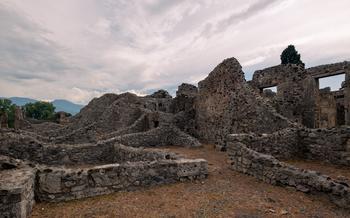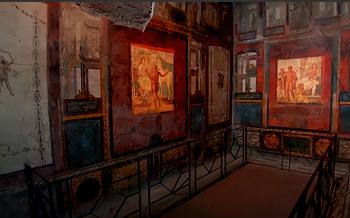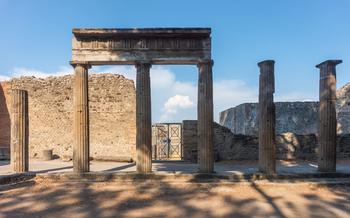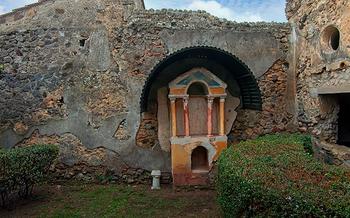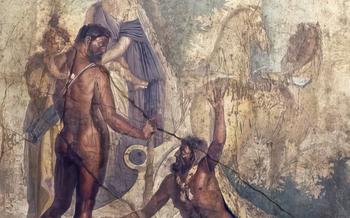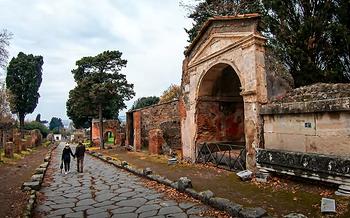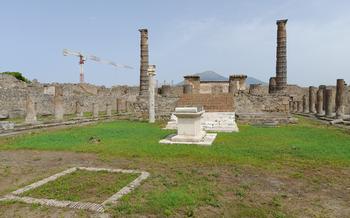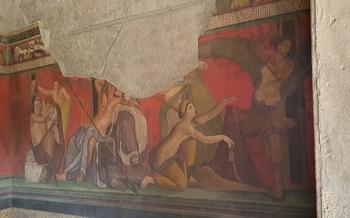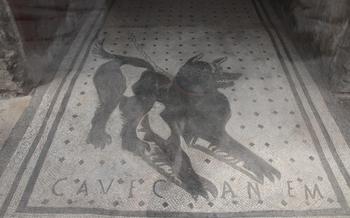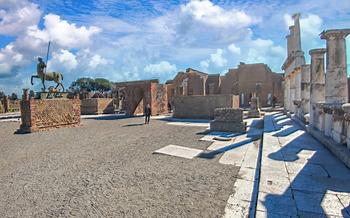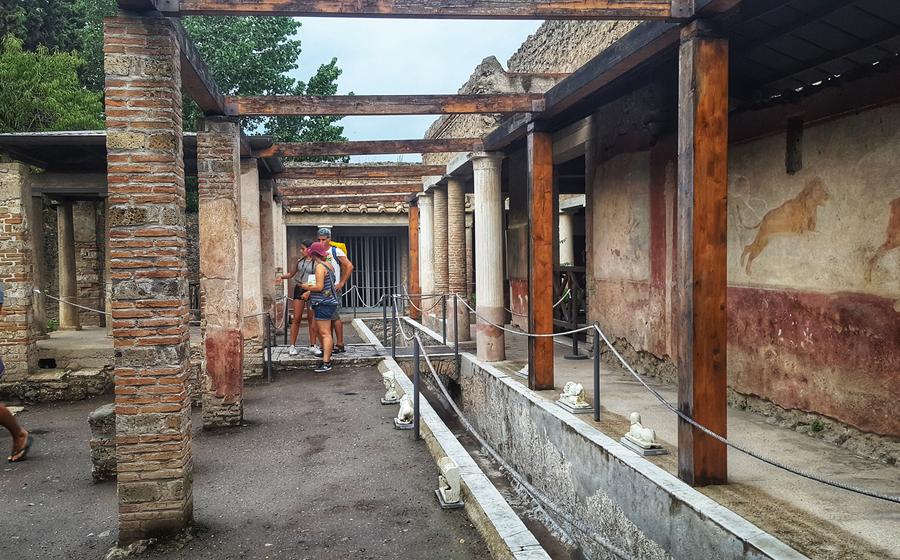
House of Loreius Tiburtinus
- A Journey Through Time: Exploring the House of Loreius Tiburtinus in Pompeii
- Location and Accessibility: Finding the House of Loreius Tiburtinus
- Historical Significance: Unveiling the Life of Loreius Tiburtinus
- Mosaic Masterpieces: Walking on History
- Architectural Elements: A Testament to Roman Engineering
- Pompeii's Destruction: The Tragic End
- Excavation and Restoration: Unearthing the Past
- Tips for Visitors: Making the Most of Your Visit
- Nearby Attractions: Exploring Beyond the House
- Food and Drink: Local Delicacies to Savor
- Insider Tip: Hidden Gems and Secret Spots
A Journey Through Time: Exploring the House of Loreius Tiburtinus in Pompeii
Pompeii, a once-thriving Roman city, stands as a testament to the catastrophic eruption of Mount Vesuvius in 79 AD. Amidst the ruins of this ancient metropolis, the House of Loreius Tiburtinus emerges as a captivating relic, offering a glimpse into the life and times of a prominent citizen.
Loreius Tiburtinus, a wealthy merchant and politician, played a pivotal role in Pompeii's society. His opulent residence, strategically located near the city's political and commercial center, reflects the affluence and grandeur of its owner. The House of Loreius Tiburtinus stands as a testament to the architectural prowess and artistic sensibilities of the ancient Romans.
A visit to this remarkable site promises an immersive journey through time, allowing visitors to step back into the vibrant world of Pompeii and uncover the captivating stories of its inhabitants. From the intricate frescoes adorning the walls to the stunning mosaic floors depicting mythological scenes, the House of Loreius Tiburtinus offers a glimpse into the daily lives, customs, and beliefs of the ancient Pompeians.
Prepare to be awed by the sheer beauty and historical significance of this remarkably preserved ancient dwelling. As you wander through its rooms, imagine the footsteps of Loreius Tiburtinus and his family echoing through the centuries, bringing to life the bustling atmosphere of a bygone era.
Location and Accessibility: Finding the House of Loreius Tiburtinus
The House of Loreius Tiburtinus stands proudly in the heart of Pompeii, a site steeped in history and frozen in time. To reach this ancient dwelling, visitors can embark on a scenic stroll through the well-preserved streets of Pompeii, following the signs that lead to this remarkable attraction.
For those seeking a more organized experience, guided tours provide an excellent option. These tours, led by knowledgeable guides, offer insights into the city's history and customs, ensuring that visitors delve deeper into the significance of the House of Loreius Tiburtinus. Alternatively, independent travelers can explore at their own pace, using guidebooks or smartphone apps to navigate the ruins.
The House of Loreius Tiburtinus opens its doors to visitors from 9am to 5pm, providing ample time to wander through its rooms and explore its intricate details. Admission fees are typically included in the overall entrance ticket for Pompeii, offering great value for history enthusiasts seeking an immersive experience.
Historical Significance: Unveiling the Life of Loreius Tiburtinus
**ius Tiburtinus played a significant role in the city's political and economic affairs. As a successful businessman and politician, he held various positions of power, including that of aedile, responsible for overseeing public works and organizing festivals. His influence and wealth are evident in the grandeur of his residence, which stands as a testament to his status and contributions to Pompeii's development.
Architectural Features: The House of Loreius Tiburtinus showcases remarkable architectural elements that reflect the luxurious lifestyle of its owner. Built around an atrium, the traditional central courtyard, the house features a peristyle garden with a central pool, surrounded by elegant colonnades. The triclinium, or dining room, is adorned with intricate frescoes and mosaics, highlighting the opulence and sophistication of ancient Roman banquets.
Daily Life and Customs: A visit to the House of Loreius Tiburtinus offers a glimpse into the daily life and customs of ancient Pompeiians. The house's layout, with its separate areas for living, dining, and sleeping, provides insights into the social structure and familial relationships within a wealthy Roman household. The presence of bedrooms, kitchens, and service quarters sheds light on the roles and responsibilities of various members of the household, including slaves and freedmen.
Mosaic Masterpieces: Walking on History
In addition to the stunning frescoes, the House of Loreius Tiburtinus is adorned with intricate and captivating mosaic floors. These mosaics are not merely decorative; they serve as storytelling mediums, depicting mythological scenes, geometric patterns, and symbolic motifs. The craftsmanship and attention to detail in these mosaics are truly remarkable, offering a glimpse into the artistic prowess of ancient Roman artisans.
One of the most striking mosaics in the house portrays the scene of Achilles dragging the body of Hector around the walls of Troy. The intricate depiction of the characters, their expressions, and the movement of the figures is simply breathtaking. Another notable mosaic features a lively depiction of a marine scene, with colorful fish, dolphins, and sea creatures swimming amidst waves and rocks. The vibrant colors and realistic details bring the underwater world to life, creating a sense of tranquility and wonder.
The symbolism embedded in the mosaics is equally fascinating. For example, a mosaic depicting a rooster and a snake represents the eternal battle between good and evil. Another mosaic features a scene of Dionysus, the god of wine, surrounded by his followers. These mosaics not only add to the aesthetic beauty of the house but also provide valuable insights into the beliefs and values of ancient Pompeiians.
As you walk through the House of Loreius Tiburtinus, take the time to admire the intricate mosaic floors. These masterpieces are not just decorative elements; they are windows into the past, offering glimpses into the artistic traditions, storytelling techniques, and symbolic language of ancient Roman culture.
Architectural Elements: A Testament to Roman Engineering
The House of Loreius Tiburtinus showcases exceptional architectural elements that provide a glimpse into the advanced engineering and construction techniques of the ancient Romans. The house's sturdy walls, built using a combination of brick and stone, demonstrate their mastery of structural stability. The use of arches and vaults, particularly in the peristyle, not only adds visual interest but also highlights their understanding of load distribution and support systems.
Another remarkable feature is the house's intricate water management system. Underground channels and conduits ensured a steady supply of fresh water to the house, while drainage systems effectively channeled wastewater away from the property. These systems not only provided essential sanitation but also contributed to the overall comfort and hygiene of the household.
Furthermore, the house's well-preserved interior reveals the use of colorful frescoes and mosaics, which adorned the walls and floors, adding both aesthetic appeal and narrative elements to the living spaces. These decorative elements often depicted mythological scenes, geometric patterns, and floral motifs, reflecting the artistic tastes and cultural influences of the ancient Romans.
Exploring the architectural elements of the House of Loreius Tiburtinus offers visitors a deeper appreciation of Roman engineering prowess and design principles, providing insights into the advanced urban planning and construction techniques that shaped ancient Pompeii.
Pompeii's Destruction: The Tragic End
In the year 79 AD, tragedy struck Pompeii when Mount Vesuvius, a nearby volcano, erupted violently, unleashing a catastrophic cascade of events. The once-thriving city was buried under a thick layer of volcanic ash and pumice, preserving it in a remarkably intact state.
The eruption began with a series of powerful earthquakes, causing widespread panic and damage. As the lava flowed inexorably towards Pompeii, the inhabitants had little time to escape. Many sought refuge in their homes, hoping to outlast the disaster. However, as the ash and pumice rained down, the city was plunged into darkness, and the air became thick with deadly gases.
The House of Loreius Tiburtinus, like many other structures in Pompeii, was engulfed by the volcanic debris. The eruption's fury spared no one, and the inhabitants perished within the walls of their sumptuous home. The layers of ash and pumice acted as a protective shell, preserving the house's structure and contents, offering a poignant glimpse into the lives of its occupants and the cataclysmic event that brought their world to an abrupt end.
The catastrophic eruption of Mount Vesuvius not only claimed the lives of thousands of Pompeians but also immortalized their city as a symbol of resilience and tragedy. Today, visitors to Pompeii have the opportunity to walk through the remarkably preserved streets and buildings, gain insights into the daily lives of the ancient Romans, and witness the devastating impact of a natural disaster that forever changed the course of history.
Excavation and Restoration: Unearthing the Past
The rediscovery of Pompeii began in the 18th century, and the House of Loreius Tiburtinus was among the first structures to be excavated. However, it wasn't until the 19th century that systematic excavations under the direction of Giuseppe Fiorelli brought the site to light. Fiorelli introduced innovative techniques, such as creating plaster casts of human remains, which provided valuable insights into the final moments of Pompeii's inhabitants.
Excavating the House of Loreius Tiburtinus posed unique challenges due to its intricate architecture and the fragile state of the ruins. Archaeologists carefully removed layers of ash, pumice, and debris, using delicate tools and techniques to preserve the integrity of the site. The process required immense patience and precision to uncover the well-preserved frescoes, mosaics, and artifacts that now captivate visitors.
Preserving the ancient ruins of Pompeii is an ongoing endeavor. Restoration efforts aim to stabilize the structures, protect them from further deterioration, and enhance the visitor experience. The House of Loreius Tiburtinus has undergone extensive restoration work, including structural reinforcement, cleaning and conservation of frescoes, and repairs to damaged mosaics.
Thanks to the dedication and expertise of archaeologists and conservators, the House of Loreius Tiburtinus stands as a testament to the resilience of Pompeii and the enduring legacy of ancient Roman culture.
Tips for Visitors: Making the Most of Your Visit
To make your visit to the House of Loreius Tiburtinus a memorable and enjoyable experience, here are some tips to keep in mind:
Optimal Timing: Aim to visit early in the morning or late in the afternoon to avoid the midday heat and crowds. The morning light is also ideal for capturing stunning photographs of the intricate frescoes and mosaics.
Guided Tours: Consider joining a guided tour, especially if you want to delve deeper into the history and significance of the House of Loreius Tiburtinus. Guided tours often provide expert insights and anecdotes that can bring the ancient ruins to life.
Essential Items: Ensure you wear comfortable shoes suitable for walking on uneven surfaces. Bring a bottle of water, sunscreen to protect yourself from the sun, and a camera to capture the captivating beauty of the site.
Accessibility: The House of Loreius Tiburtinus is wheelchair accessible, allowing visitors with mobility challenges to explore the site with ease.
Mindful Exploration: Be respectful of the ancient ruins and avoid touching or damaging any artifacts. Remember that these are precious remnants of a bygone era that we must preserve for future generations.
Nearby Attractions: Exploring Beyond the House
Pompeii is a treasure trove of ancient ruins, and the House of Loreius Tiburtinus is just one of the many fascinating sites to explore. To make the most of your visit, consider venturing beyond the House and exploring other nearby attractions that offer a glimpse into the rich history and culture of this ancient Roman city.
One must-see attraction is the Temple of Apollo, located in the heart of Pompeii's religious district. Dedicated to the god Apollo, this well-preserved temple features impressive Doric columns, intricate frescoes, and a sacred altar.
Another highlight is the Pompeii Amphitheater, one of the oldest and best-preserved Roman amphitheaters in the world. With a capacity of over 20,000 spectators, this massive structure hosted gladiatorial contests and other public spectacles.
For those interested in art and architecture, the House of the Tragic Poet is a must-visit. Named after a mosaic depicting a scene from a Greek tragedy, this lavish residence boasts beautiful frescoes, sculptures, and a stunning peristyle garden.
For a unique perspective of Pompeii, climb to the top of Mount Vesuvius, the volcano that famously erupted in 79 AD and buried the city under layers of ash and pumice. The hike to the summit offers breathtaking views of the surrounding landscape, including the ruins of Pompeii.
To create a comprehensive itinerary, consider the following walking routes:
Pompeii in a Day: Start with the House of Loreius Tiburtinus, then visit the Temple of Apollo, the Pompeii Amphitheater, and the House of the Tragic Poet. Finish the day with a panoramic view from Mount Vesuvius.
Pompeii Off the Beaten Path: Explore lesser-known ruins such as the Stabian Baths, the Villa of the Mysteries, and the House of the Vettii. Discover hidden gems like the Garden of the Fugitives and the Secret Passage.
Pompeii for History Buffs: Immerse yourself in the city's history at the Pompeii Archaeological Museum, which houses artifacts and exhibits from the ancient ruins. Visit the Pompeii Forum, the center of political and commercial life, and explore the ruins of the Lupanare, a brothel.
By exploring these nearby attractions, you'll gain a deeper understanding of Pompeii's rich history and culture, and create lasting memories of your visit to this ancient city.
Food and Drink: Local Delicacies to Savor
When visiting Pompeii, immersing yourself in the local cuisine is a must. Take this opportunity to savor the flavors that once filled the streets and homes of ancient Pompeiians.
-
Pompeian Delights: Indulge in traditional dishes that have stood the test of time, such as "pizza fritta," a fried pizza topped with fresh tomatoes and cheese, or "migliaccio," a ricotta-based cake flavored with orange blossom water.
-
Must-Try Street Food: Experience the vibrant street food scene of Pompeii. Sample "panuozzi," a sandwich filled with local cheeses and meats, or "panzerotti," fried dough pockets stuffed with savory fillings.
-
Authentic Restaurants: For a sit-down meal, choose from the many restaurants near the House of Loreius Tiburtinus. Opt for an "osteria" or "trattoria" for a traditional ambiance and menu.
-
Local Flavors: Don't miss the chance to try regional specialties like "spaghetti alle vongole," pasta with clams, or "frittura di paranza," a mixed fried seafood platter.
-
Culinary Souvenirs: Take a piece of Pompeii's culinary heritage home with you by purchasing local products such as olive oil, limoncello liqueur, and handmade pasta.
Insider Tip: Hidden Gems and Secret Spots
In addition to the main attractions, the House of Loreius Tiburtinus offers hidden gems and secret spots that will delight curious explorers. For a truly unique experience, venture beyond the well-trodden paths and explore these lesser-known areas:
-
Secret Garden: Step into a tranquil oasis tucked away from the hustle and bustle of the ruins. Discover the hidden garden, where fragrant flowers, lush greenery, and the gentle sound of water create a serene atmosphere.
-
Underground Passage: Descend into the depths of Pompeii and uncover a hidden underground passage that once connected different parts of the city. Imagine the secrets that these ancient tunnels hold.
-
Private Terrace: Ascend to the upper levels of the House of Loreius Tiburtinus to find a secluded terrace with breathtaking views of Pompeii and the surrounding countryside. Enjoy a moment of tranquility while soaking in the panoramic vistas.
-
Hidden Alcoves: Keep an eye out for concealed alcoves and niches throughout the house. These tucked-away spaces often hold unique frescoes, mosaics, or architectural elements that offer glimpses into the lives of Pompeii's inhabitants.
-
Off-the-Beaten-Path Itineraries: To avoid the crowds and discover Pompeii's hidden treasures at your own pace, consider exploring the city using off-the-beaten-path itineraries. Walk along the lesser-known streets, visit smaller ruins, and engage with local artisans to gain a deeper understanding of Pompeii's rich history and culture.
